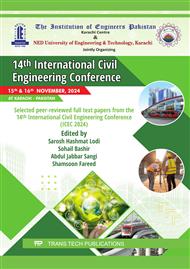p.91
p.101
p.109
p.117
p.127
p.139
p.149
p.157
p.165
Infrastructure and Disaster Risk: A Comparative Study of Pakistan and other Nations (By C.M.S. Akbar, Et Al.)
Abstract:
As compared to most of the developed countries, Pakistan’s infrastructure has room for improvement and has disaster handling issues. In the construction industry of Pakistan the factor of infrastructure resilience is irrelevant. However, it is a priority in emerging and first-world economies, as they allocate significant resources towards updating and maintaining key systems with the help of sophisticated risk evaluation tools. Neglect of structures through lack of proper maintenance results in early failures especially during flood disasters. Additionally, urbanization occurs at a very fast rate, and this has a detrimental effect on the urban infrastructure, and consequently leads to urban flooding since there is no emphasis placed on matters concerning drainage with the increased population of the cities. Thus, it is important to acknowledge that the questions of infrastructure development and maintenance are very sensitive and influential when it comes to identifying the risks of disasters and disaster management. China for instance- a neighbor to Pakistan and whose economy is still deemed as an emerging economy, has improved in disaster management as they have developed high disaster resilient infrastructure structures such as highraise flyovers and earthquake resistant buildings amongst others among others. However, availability of replacement assets for quick repair in the aftermath of disasters has made it possible to undertake quick recovery even with the aforementioned constraining factors. Thus, in order to achieve enhancement of disaster risk reduction Pakistan needs to acknowledge the significance of infrastructure that discriminates as one of the most significant facets of disaster risk reduction. Some improvement can bring the best out of the global practices while adapting them to the country’s localities so that its infrastructural system, its ability to safeguard people and their assets, and developmental accomplishments are enhanced.
Info:
Periodical:
Pages:
127-136
Citation:
Online since:
April 2025
Price:
Сopyright:
© 2025 Trans Tech Publications Ltd. All Rights Reserved
Share:
Citation:


